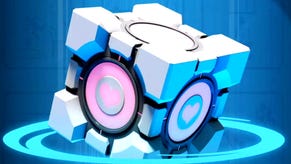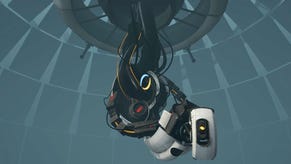Portal 2
Holesome.
You're not alone, either. You never were in Portal, obviously, as the ominous doublespeak chatter of GLaDOS echoed through the game's mazes, but here you're joined, initially at least, by somebody entirely new: the benign and flustered Wheatley, a roving mechanical eyeball voiced – wonderfully voiced – by Stephen Merchant.
Unlike GLaDOS, Wheatley just wants to help – failing that, he'll do his best to ensure you get a decent burial – and he makes for a lovely, warm-hearted counterpart to the slick salesmen tones of the facility's pre-recorded emergency messages, which are disarmingly eager to prepare you for life in a world where animals may have come to rule the planet or where meteors may be incessantly pounding the earth from above.
In amidst the jokes and the post-apocalyptic intrigue, however, the tutorial levels, which terminate in truly terrifying – and spoilerish – form, provide a real insight into how much fun there is still to be found with even the game's most basic toolset.
The initial test chambers may only let you use one half of the Portal Gun's powers – and may restrict other gadgets to cubes and the occasional switch – but they manage to cram a surprising amount of mind-bending puzzlement into the action as they weave you through reintroductions to everything from platforming, navigating impenetrable walls, and the way that mass and velocity combine with portals to allow you to move about the environment in a surprisingly gymnastic manner.
With the tutorial done with, it's up to a brief tour of the separate co-op campaign to introduce a few of the game's new ideas – the first of which, obviously, is the fact that there's now a separate co-op campaign. Focusing on the Laurel and Hardy duo of Orangebot and Bluebot, the new adventure may depend on the same puzzle pieces as the single-player content, but it manages to make them feel entirely distinct.
For one thing, this is co-op of a far more intimate and co-ordinated kind than you might be used to in an FPS or RPG. Levels may be quick to separate you from your buddy behind a sheet of glass or a gap in the floor, but you absolutely have to work together to get to the exit, whether you're passing cubes back and forth through slots to activate a series of pressure plates, or simply doubling up the numbers of portals you can fire to thread a beam of light across a room full of obstacles.
New gadgets, such as a lens cube, which allows you redirect laser beams, seem bubbling over with potential for triggering switches, taking out turrets, or just singeing your partner for the heck of it, and a new pointer device provides an easy way for you to direct your accomplice's portal placement, or highlight new objectives. Brilliantly, there's even a range of gestures, activated on consoles via the d-pad, which let you wave, high-five, or beckon to each other. It feels like an implausibly brainy reinvention of ToeJam & Earl at times, and because there's two of you muddling along, things can go wonderfully awry.
An hour messing around with Portal 2, then, is enough to change it from a pleasant prospect to a truly unmissable one. With some promising new ideas and some great old ones, Valve shouldn't have too many troubles enticing people back to its mean-spirited geometrical playground. Maybe after that, the team will get to work on reinventing the Rubik's Cube after all.








